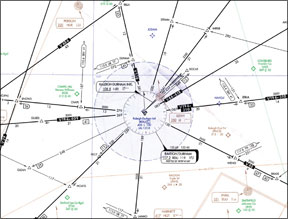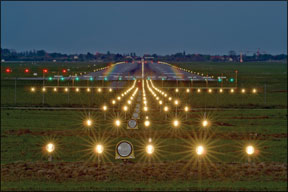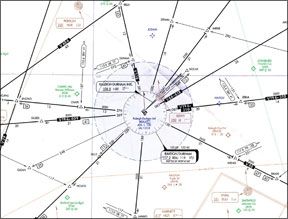Im either lucky or I dont fly enough: In more than 30 years of flying airplanes for personal transportation, Ive had to execute a for-real missed approach in IMC exactly twice. On both occasions, weather was the main culprit. At least thats my excuse. Both flights ended after a successful ILS approach. Of course, those two occasions dont include the trips I delayed or didnt make for weather-related reasons. 288 In more than one instance, Ive waited out weather but still arrived at my destination before I had to be there. Theres no real secret to this kind of reliable personal-airplane use. Its a fairly simple matter of planning, keeping open as many options as possible, knowing what the options are and then-when its necessary-making the decision to execute the appropriate plan. One Miss My more recent for-real miss was really my own fault, with a little help from the weather. My destination was home plate at the time, the Manassas (Va.) Regional Airport (HEF). The wind was honking, both on the surface and at altitude. I was shooting the RNAV (GPS) Rwy 34R approach, for which the initial approach fix (IAF) is the Brooke (BRV) Vortac several miles south. As it happens, BRV is also a feeder fix for an arrival to nearby Washington-Dulles International, and theres a lot of pressure to keep up the RJ-set pace when inbound to that airspace. This also was my first time shooting a GPS approach in anger. Wanting to keep moving, I left my Debonairs power at a near-cruise setting after hitting BRV and starting a letdown. The honking winds gave me something like a 30-knot tailwind during this phase of the approach so I was covering ground quite nicely. Too nicely, as it turned out, since I couldnt get down and slow down enough to be anywhere near even the approachs circling MDA, much less the straight-in value. Still in the clouds, I watched the moving maps airport symbol slide quickly down the screen as the magenta line above the little airplane symbol got shorter and shorter. As I flew over the approach end of 34R, I was still several hundred feet too high and in the clouds; there was no runway in sight, even though the field was basically VFR. After calling a miss to ATC, I could hear the frustration in the controllers voice, giving me a vector and asking my intentions. Sucking up the gear and putting myself fully into go-around mode, I happened to glance down and saw the airports parallel runways, lit up in the darkness as fast-moving clouds passed between us. Briefly, the thought occurred to pull off all the power, dirty up, and spiral down to a landing. But, I was out of position for the runway layout. And I figured the guys in the tower would take a dim view of such shenanigans. Plus, I hate to fill out all the paperwork that maneuver likely would entail. My intentions? My intentions were to get in on the first approach, silly. But, not having slowed down earlier, I had screwed that pooch all by myself. Instead, I asked for the ILS Rwy 16L, a procedure designed to take me to the same pavement I was aiming for a moment earlier, albeit to its opposite end. With the tailwind I had, I would be past the ILSs FAF in a couple more minutes; it would be a simple matter to reprogram the magic, make a 180 to the right-into the wind-and follow the electronic glidepath. And thats what we did. The rest of the approach and landing was anti-climactic. Embarrassed, I skulked/taxied to my hangar, put the airplane away and didnt even glance in the towers direction, lest they were using their binoculars, trying to get a good look at the idiot who couldnt get in the first time. Another Miss Things werent so embarrassing the other time I had to shoot a real missed approach. I was inbound to the Raleigh-Durham area from the southeast, flogging a Skyhawk. The whole east coast was going down the tubes and ATC was busy. I had a passenger wanting to be dropped at Chapel Hill, N.C.s, Horace Williams Airport. I and another passenger planned to top the tanks and go on to the D.C. area that night. This was several years ago, before the Chapel Hill airport gained published approach procedures. At the time, the only approach was an old-fashioned airport surveillance radar (ASR) procedure, with an MDA of 600 feet agl. Soon, I was working with the local Tracon, who briefed me that their ASR approach called for inbound aircraft to approach from either the east or the west. From which direction did I want to approach the destination, I was asked. It didnt take long for me to answer. Although approaching from the east for Runway 27 would have meant the shortest distance and least amount of flying to get to the airport, I knew the weather already was at or below the approachs minimums; there was a real possibility of missing. The controllers question really was more along the lines of, “Where do you want to be pointed when you miss this approach and where are going to go?” In a Skyhawk, of course, one has plenty of time to plan. I already had listened to the ATIS at nearby Raleigh-Durham International (RDU) and knew they were landing Runways 5L and 5R, but the ceiling was dropping fairly quickly. As I recall it was already below 300 feet, headed for Category I minima of 200 feet, and the visibility was around a mile. I was confident in my abilities, as well as the airplane, so I wasnt worried about the low IFR. I really wanted to get my passenger into Chapel Hill, although I had briefed her on the situation and she accepted the likelihood wed probably have to go into RDU. 288 Thankfully, I recognized the controllers question for what it was and told ATC I wanted to approach from the west, aimed at Chapel Hills Runway 9. If I missed, I told him, Id be requesting vectors for the ILS into RDU. He thought that was a grand idea. Sure enough, after descending to the ASR procedures MDA, there was nothing at all to see. As the controller called the airport at 12 oclock and less than a mile, I added power for the climb and called the miss. I was greeted with clearance for a climb and vectors for the ILS Runway 5R at RDU, for which I had already pulled out the plate and tuned the radios. Again, the ensuing approach and landing were uneventful. The passenger found a ride and bid us farewell, while the rest of us held out hope of getting fuel and bugging out. Did I mention the whole east coast was down the tubes? We ended up spending the night. While I was ready and willing to launch into the low IFR at RDU and slog through it all the way back to the D.C. area, there was no legal alternate within the Skyhawks range. And there was a good chance I would need one. The next morning turned out to be a fine time for flying, though. One More It wasnt really a missed approach, but it was a diversion. I was trying to get into Oshkosh in 2003, during AirVenture. A buddy and I had launched earlier that morning from HEF, flying non-stop to the Ripon area. We were planning to get in ahead of the airport closure for the afternoons airshow. Unfortunately, we arrived at about the same time as a major thunderstorm. The controllers at Fisk were directing everyone into holding at Rush Lake, so we orbited the lake in loose formation with a dozen or so very close friends. After a couple of circuits, however, the controllers announced the field was closing for the thunderstorm and would remain closed until after the airshow, some three hours later. While we had the gas to wait out the thunderstorm in the hope the field would reopen before the air show, orbiting the lake is boring. So, we dialed up Appleton, Wis., and punched direct. After unloading and hurriedly securing a rental car, we arrived at OSH just as the air show was getting underway. Easy peazy. Lessons Learned The first lesson learned is one I forgot when making the GPS approach to HEF: Always plan for the miss; be surprised when you get in, not when you dont. I had forgotten this basic rule of real-world IFR flying and no one was more surprised when I went missed. As it was, I was at my home plate, so I knew the nearby facilities, approaches and navaids pretty much by heart. Going missed here was a minor inconvenience-it was something more than that to the controllers, of course. I did it right at RDU. I knew there was a very good chance I wouldnt get in, planned to miss the approach, had a very good Plan B in mind, ATC knew what the plan was and we implemented it smoothly. Thats the way its supposed to work. Another lesson learned is not to try the same approach again unless you know what went wrong. We could expand that to include not trying the same airport, but my escapade at HEF is the exception to such a rule. This months Accident Probe (see page 24) details what can happen when this rule is broken. As we discuss, theres simply no good reason to be executing-and missing-multiple approaches to the same runway. The exception is, again, unless we know what went wrong. In this instance, however, the corollary is we can fix what went wrong. In the accident detailed beginning on page 24, the pilot either didnt know what went wrong or erroneously thought he could fix it. In any event, that episode is pretty much the definition of insanity attributed to Albert Einstein: doing the same thing over and over again and expecting different results. Two other lessons come to mind in addition to those summarized above. One is to know the weather trends. In the episode at RDU, we were heading into deteriorating weather: The ducks were going to be walking soon. We knew it, we were prepared for it and we had more than one plan. Plan A was to get into Chapel Hill. Plan B was the ILS into RDU. Plan C for this scenario was to turn around and go back the way wed come. We had the gas and knew the overflown stations had better weather, offering improved chances of getting in if we missed the ILS at RDU, a decent possibility. The final lesson has to do with FAA regulations on filing legal alternates. Of course, the FAA wants this information so ATC will know where youre planning to go after you go Nordo and miss the approach at your intended destination. The exercise of planning for a legal alternate is a good one, and helps us ensure we have a workable Plan B. In my mind, though, Plan B really is the nearest ILS. My current home drome, the Venice (Fla.) Municipal Airport (VNC), has a single approach, an NDB/GPS procedure with 603-foot minima. If I miss that, Im aimed at nearby Sarasota-Bradenton, with its two ILSes. If that doesnt work, theres Tampa, St. Pete and MacDill AFB. If none of 

Some other lessons to take away from all this diverting are summarized above. Its easy to sit back, relaxed as I was on the GPS approach into HEF, and presume youll make it in the first time. Easy, that is, until you have to scramble to come up with a Plan B. Much better-and easier on the adrenaline-to come up with Plan B well before you need it. As my double-I used to say, “Now, while youre cruising in straight and level flight, is a good time to get set up for the approach.” He was right then, and hes right now.




